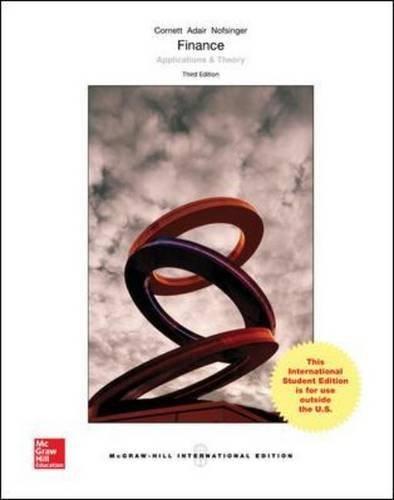Question
Company Analysis: Dan no longer works for Alphabet, but he has a relatively large amount of his personal wealth tied up in both company stock
Company Analysis:
Dan no longer works for Alphabet, but he has a relatively large amount of his personal wealth tied up in both company stock and debt. Consequently, he would like an objective review of the company today and its future prospects. He would also like an opinion on the stocks equity and bond valuations. Dan has sufficient alternative assets and doesnt need to sell his ABCD stock or bonds, but he is becoming concerned about increasing inflation and is reviewing all of his holdings.
Economic Environment:
The risk-free rate is at 4.2%. The economy is just coming out of a recession, but Alphabet is in an early cycle industry and is already recovering (after a downturn in 2007). Alphabets earnings are expected to grow 12%. Inflation is running at 3%, but both Dan and economists are concerned that inflation could rise to 6% within five years.
Alphabet Corp - Income Statement
| |||||||||||||||||||||||||||||||||||||||||||||||||||||||||||||||||||||||||||||||||||
Alphabet Corp Balance Sheet
| |||||||||||||||||||||||||||||||||||||||||||||||||||||||||||||||||||||||||||||||||||||||||||||||||||||||||||||||||||||||||||||
LT Debt 3 MM at 11% maturing 2015, 5 MM at 8% maturing 2020.
QUESTION 16
| Year | After-tax Cashflows | Synergistic Savings |
| 1 | $150,000 | $40,000 |
| 2 | $340,000 | $40,500 |
| 3 | $420,000 | $50,000 |
| 4 | $500,000 | $50,000 |
| 5 | $600,000 | $50,000 |
| 6-10 | $640,000 | $30,000 |
Synergistic gains often occur when two companies are merged. The combination may result in net savings from duplication of staffing in accounting and administrative, legal, distribution, etc. Based on both the 10-years of after-tax cashflows and synergistic savings does this merger make sense based on an internal rate of return of 8% and a positive net present value?
| Yes, the net present value of the acquisition is positive and the IRR% is greater than the required 8% return on investment rate. | ||
| Yes, the net present value of the acquisition is negative but the IRR% of the acquisition is positive | ||
| No, the net present value of the acquisition is negative and the IRR% is less than the required 8% return on investment | ||
| No, the net present value of the acquisition is negative but the IRR% of the acquisition is positive |
QUESTION 17
The CFO of Alphabet is a little nervous about the acquisition and the calculations assumptions. What are some ways that she might build in a margin of safety?
(1) Increase the discount rate
(2) Decrease the discount rate
(3) Increase the cashflow assumptions
(4) Decrease the cashflow assumptions
| a. | 2 and 3 | |
| b. | 1 and 4 | |
| c. | 1 and 3 | |
| d. | 2 and 4 |
QUESTION 18
Alphabet is considering making an even larger acquisition for $8,000,000, but first needs to compute its current Weighted Average Cost of Capital. Alphabet will be using only debt and equity, and wants to keep its ratio of LT Debt to Equity constant. The price of Alphabet stock is $13, and the expected growth rate is 10%. Assuming no additional issuance costs, what is the WACC?
| 9.87% | ||
| 11.56% | ||
| 10.86% | ||
| 13.50% |
QUESTION 19
The Board of Directors is reviewing executive compensation. Which of the following are viable alternatives that would align the CEO with the shareholders?
(1) A combination of quarterly ROE and ROI
(2) A combination of yearly EVA and MVA measures
(3) Bonuses based on 5 year financial performance
(4) A compensation package that is transparent to shareholders
| All of the answer choices. | ||
| 1, 2 and 3 | ||
| 2, 3 and 4 | ||
| 1 and 3 |
QUESTION 20
Dan has come across an opportunity to buy an apartment building for $1,250,000, but isnt sure. He can get a loan for 80% of the buildings value at 8%, but because of the risks Dans own required return is 12%. Given the following annual cash flows, what is the building worth to Dan?
Gross Rents 210,000
Expected vacancy 7%
Utilities, Insurance, taxes 48,000
Interest 24,000
Maintenance 10,800
Capital Repair Fund 10,000
Mgt. Fees 12,000
Depreciation 32,000
| $1,037,500 | ||
| $1,020,833 | ||
| $1,556,250 (50% credit) | ||
| $ 754,166 |
Step by Step Solution
There are 3 Steps involved in it
Step: 1

Get Instant Access to Expert-Tailored Solutions
See step-by-step solutions with expert insights and AI powered tools for academic success
Step: 2

Step: 3

Ace Your Homework with AI
Get the answers you need in no time with our AI-driven, step-by-step assistance
Get Started


